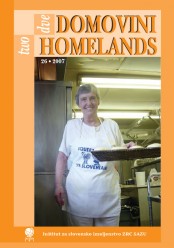The importance of the church and religious congregations for Slovenian and Norwegian migrants to the United States of America. A comparative aspect
Keywords:
emigration to USA, church, religious congregations, social and charity work, settlers’ communitiesAbstract
Slovenia and Norway, both small European countries, have a history of being occupied by other forces. The first had a Catholic Church, the second a Lutheran, both with a bulk of primarily rural forefathers going to America in the nineteenth century, though with a time span of forty years in-between. It became a challenge to see which differences and similarities this situation, especially the churches, brought to the emigrants in the process. No doubt, the religion influenced their lives, Slovenian Church being more autocratic, the Norwegian democratic. Both gave support in education, charity work, social and cultural activities, but under different conditions. The positive effects are easy to spur, and the long-term Americanisation effects will need a broader perspective.
Downloads
References
Bleken, M.K. 1914: De Norsk-Amerikanske skoler (“The Norwegian-American Schools”). In: The Promise of America. Articles and texts. (http://www.nb.no/emigrasjon/emigration/2nd_ar.html).
Canuteson, Richard L.: Lars and Martha Larson: “We do what we can do for them.” In NAHA,Volume 25, page 142. (www.stolaf.edu/naha/pubs/nas/volume25/ vol125_6.htm).
Catholic Encyclopaedia (http://www.newadvent.org/cathen/14042a.htm).
Drnovšek, Marjan, 1992: The Attitude of the Slovene Catholic Church to Emigration to the United States of America before 1914. Slov.stud., vol.14, no 2.
Drnovšek, Marjan, 1994: Mass emigration and Slovenes. Dve Domovini, Two Homelands. No.5.
Drnovšek, Marjan, 2003: Ljubljana and Emigrant Agencies at the Beginning of the Twentieth Century. AEMI Journal,vol 1.
Elizabeth, Fedde, 1888: Diary, Folkedahl, Beulah ed. and translator (www.naha.stolad. edu/pubs/nas/volume20/vol20¬_9.htm).
Durkheim, Émile, 2000: Om den sociale arbejdsdeling ( ”De la division du travail social.”).
Křbenhavn, Reitzels forlag.
Friš, Darko, 1995: Ameriški Slovenci in Katoliška cerkev : 1871-1924. Celovec, Ljubljana, Dunaj: Mohorjeva založba.
Gantar Godina, Irena, 2001: Overview of the Slavs from Habsburg Monarchy to Canada – up to 1918. In: Once a Jolly Swagman…” essays on Migration in Honour of Olavi Koivukangas. Turku, Institut of Migration.
Gjerde, Jon, 1997: The Minds of the West. Ethnocultural Evolution in the Rural Middle West 1830 – 1917. The University of North Carolina Press.
Gordon, Milton M., 1904: Assimilation in American Life. The Role of Race, Religion, and NationalOrigins. New York, Oxford University Press.
Greipsland, Torbjřrn,1997: Drřm og dramatikk i det norske Amerika (”Dream and Drama in the Norwegian America”). Genesis, Oslo.
Gulliksen, Řyvind T., 1999: ”Saa nćr hverandre.” En samling amerikabrev fra Midtvesten til Nissedal 1850 – 1875 (“So Close to Each Other. A Collection of lamericaletters from the Middle West to Nissedal 1850-1875”). NAHA avd. Norge.
Kjeldstadli, Knut, 2006: Mulige framtider, Norge som et flerkulturelt samfunn Innlegg i en konferanse ved Hřgskolen i Oslo (”Possible futures, Norway as a multicultural society”). Presentation at a conference at the University College of Oslo.
Klemenčič, Matjaž, 1993: Images of America among Slovene and other Yugoslav Migrants. In: Distant Magnets: expectations and realities in the immigrant experience 1840 – 1930. New York, Holmes & Meier.
Klemenčič, Matjaž: (www.theslovenian.com/articles/klemenčič 4.htm).
Kocjančič, Cvetka, 1997: Slovene Identity: The Canadian Experience. Dve domovini, Two Homelands, no.8.
Kodrič,Majda, 1992: Slovene Emigration to the United States and the Establishment of Ethnic Communities. In: The European Emigrants’ Experience in the U.S.A. (ed. Hölbling, Wagnleitner ). Gunter Narr Verlag.
Mřnnesland, Svein, 1999: Fřr Jugoslavia og etter (”Before Yugoslavia and after”). Qsli, Sypress forlag.
Norlie, O.M, 1914: Norske prester i Amerika 1843-1913 (”Norwegian Priests in America 1843 –1914”). Minneapolis, Augsburg forlag.
Norman, Hans and Rundblom, Harald, 1987: Transatlantic Connections. Nordic Migration to the New World after 1800. Norwegian University Press.
Ostergren, Robert C., 1988: A Community Transplanted. The Transatlantic Experience of a Swedish Immigrant Settlement in the Upper Middle West, 1835-1915. Uppsala, Almquist & Wiksell international.
Preus, Johan Carl Keyser, 1957: Kirken og utflytterfolket. (”The Church and the emigrants”). De tok Norge med seg.
(http://www.nb.no/emigrasjon/vis_data_art_bok.php?lang=eng&dok_id=25461).
Rued Holand, Hjalmar, 2006: History of the Norwegian Settlement, A translated and expanded version of the 1908 “De norske Settlementers Historie”. Rosholt og Blegen, Iowa, Astri mi Astri Publishing.
Rřlvĺg, Ole, 1936: I de dage (”In those Days”). Oslo.
Rönnqvist, Carina, 2006: Svea folk I Babels land. Svensk identitet i Kanada under 1900 tallets f¨örsta hälft (”Swedish people in Babels country. Swedish identity in Canada in the first half in the 19th century”). Umeĺ Universitet, Umeĺ.
Řstrem, Nils Olav, 2006: Norsk utvandringshistorie (”Norwegian Emigrationhistory”). Det norske Samlaget, Oslo.
United States Conference of Catholic Bishops: About Migration and Refugee services. (www.nccbuscc.org/mrs/history.shtml).
Downloads
Published
How to Cite
Issue
Section
License

This work is licensed under a Creative Commons Attribution-NonCommercial-NoDerivatives 4.0 International License.
Authors guarantee that the work is their own original creation and does not infringe any statutory or common-law copyright or any proprietary right of any third party. In case of claims by third parties, authors commit their self to defend the interests of the publisher, and shall cover any potential costs.
More in: Submission chapter





